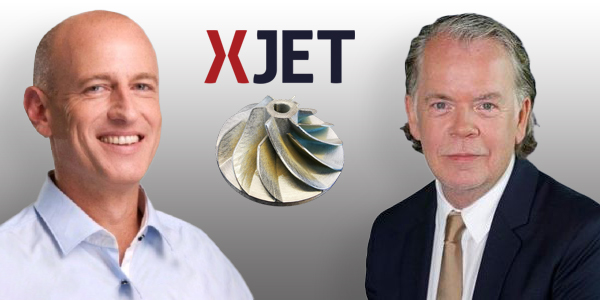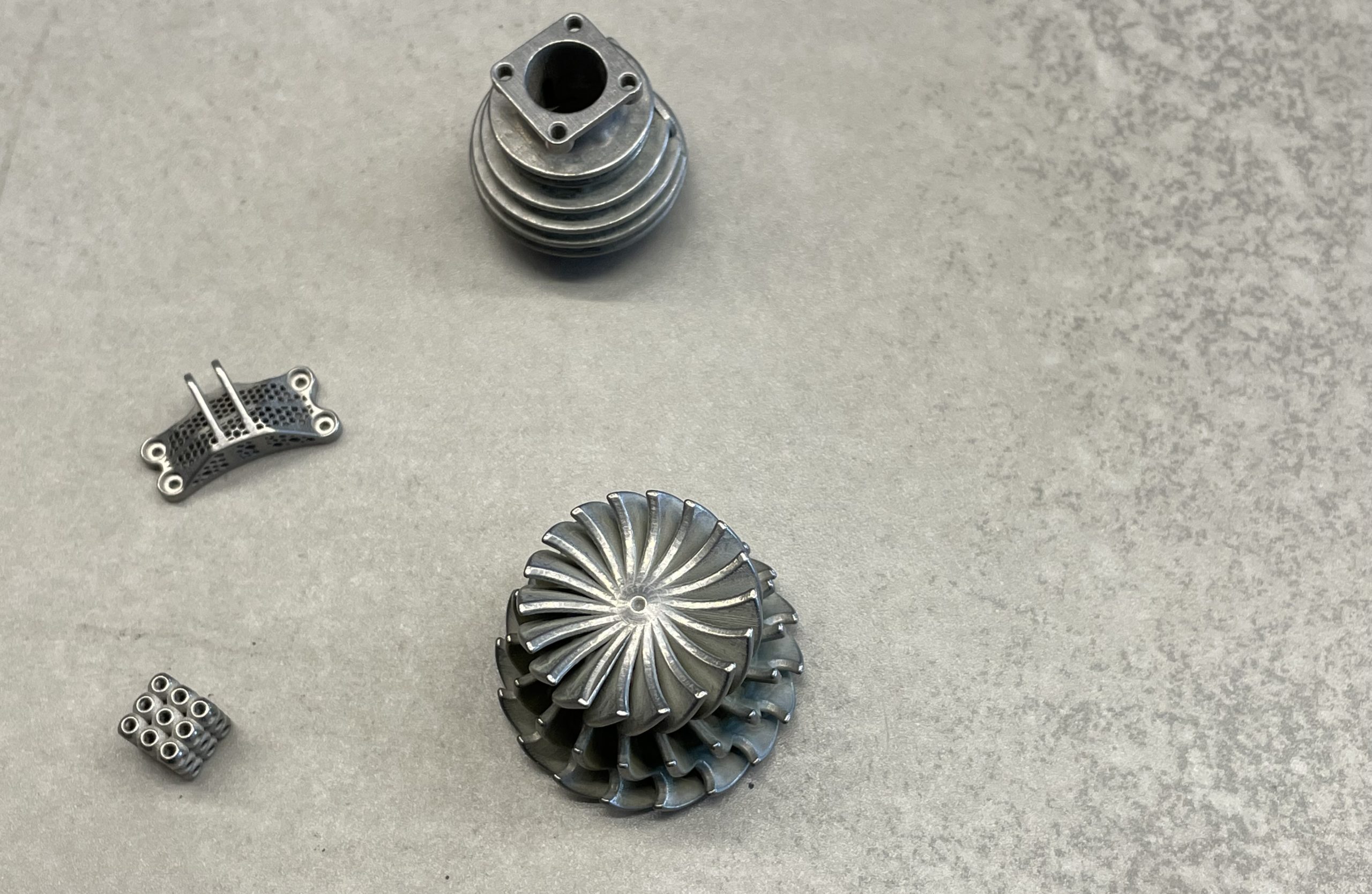When it emerged on the market in 2016, Israel’s XJet was one of the most promising startups in the additive manufacturing (AM) industry. Promising a user-friendly method for producing extremely detailed metal parts, it was on the precipice of disrupting the metal 3D printing segment. However, XJet seemed to stumble its market entry when it was unable to deliver its Nano Particle Jetting (NPJ) systems for metal to the market in the time expected.
Now, however, the high-tech firm has revamped its management, streamlined its business, and is revisiting the market with a strategy that its new leadership believes will drive XJet to the top of the pack in AM. 3DPrint.com spoke to XJet’s Chief Executive Officer, Guy Zimmerman, and Chief Business Officer, Andy Middleton, to learn more.
Deep Inkjetting Experience
XJet’s NPJ technique utilizes printheads equipped with thousands of inkjet nozzles to jet millions of ultrafine drops simultaneously, enabling the creation of designs of any complexity and density, followed by an effortless support removal process due to soluble material, and concludes with a straightforward overnight sintering process to finalize the parts.
Both Middleton and Zimmerman have deep-seated experience in inkjetting. The CBO began as an executive at HP Israel for over a decade before spending just as much time at 3D printing’s original Israeli leader, Stratasys. Middleton then joined XJet, where he led its European operations for the first 20 months. In November 2023, XJet formally began executing its restructuring and appointed Middleton as CBO.

XJet CEO Guy Zimmerman (L) and CBO Andy Middleton (R)
Zimmerman, meanwhile, was a part of the senior management team at textile inkjetting pioneer Kornit Digital, building its marketing capabilities and business development, seeing it through its initial public offering (IPO). Like Stratasys’s current CEO, Zimmerman also got his start at McKinsey.
A New Business Approach
As management changes were initiated toward the end of 2023, XJet began executing a new business strategy. According to Zimmerman, NPJ was and continues to be a truly unique and innovative technology, but it was the market approach that was lacking.
“XJet has 80 patents and had more than $100 million invested, but it was invested to develop a completely new manufacturing technology for metal and ceramics. The focus was mostly on penetration and market education.” Zimmerman said.
In turn, a major part of Zimmerman’s strategy has been to reapproach the market. Whereas, in the past, XJet pitched its technology broadly and vaguely to the market at large, Zimmerman is targeting specific verticals and applications where the high value of NPJ can be executed.

Metal parts 3D printed with NPJ. Image courtesy of Sarah Saunders at 3DPrint.com
“We are already deep into the execution phase. XJet has an extremely interesting and unique technology with potential to disrupt the industry with a unique business model that nobody in additive can have because we provide a complete solution together with proprietary materials—the inks.”
Zimmerman suggests that, in addition to the actual technological benefits of NPJ, there is a crucial economic advantage based on the fact that NPJ relies on inks, rather than powders. This in turn, offers high margins while maintaining a price point that is amenable to clientele as much as it is to XJet.
“That means that our business model—not like all others that are powder-based—is based on recurring revenue with very high margins that are already built in the economic model of this product. The customers are happy with it. The value they get from the parts is worth paying a premium on the materials because of the advantages the materials give them in manufacturing in part quality.”
XJet’s Fourfold Strategy
Zimmerman explained that, under its new leadership, XJet is implementing a multifaceted approach to reshape its strategic direction, focusing on four key areas:
Organizational and Management Restructuring
The company has undergone a significant organizational reshaping, enhancing operational efficiency and prioritizing the retention and enhancement of key personnel with specialized experience. This strategy has allowed the company to maintain its core competencies, including having the best system engineers in Israel and a top-tier business manager in the additive sector in the form of CBO Andy Middleton, alongside its own ink factory. This restructuring is aimed at fostering a more efficient and focused team, emphasizing core capabilities with a renewed spirit.
Refinement of R&D Activities
XJet has concentrated its efforts on improving its current product to drastically improve printing speed, accuracy, and reliability, which will significantly increase throughput, reduce cost per part, and expand application coverage for our customers. In turn, this is set to improve XJet’s gross margin, revenue per account, operating costs, and competitive positioning, positioning the company as a leader in fast, reliable, and high-quality part manufacturing.
Targeted Go-to-Market Strategy
The company has identified a unique advantage in producing small, high-complexity, high-value parts. This strategic shift focuses on markets where the company’s 3D printing technology outperforms others in quality, such as in surgical robotics and dental crowns, as well as fashion accessories and specific industrial niches like water fluid, desalination, and chemical processes. By concentrating on these areas, XJet aims to serve markets with high margins and no digital alternatives, moving away from broad, non-specific targeting to a more focused approach that seeks out multi-system account potential.

Expansion of Material Offerings
Addressing previous limitations in material diversity, Zimmerman plans for XJet strengthen its materials department to extend its offerings beyond the current three materials. This expansion into a slightly broader range of specialized materials is expected to quadruple the available market for the company’s products and services, making it a more versatile and attractive option for a wider range of applications.
Upgraded Machine, New Business
Altogether, these strategic changes mark a significant shift from the company’s previous broader approach, focusing now on efficiency, specialization, and targeted markets to drive growth and innovation. Zimmerman suggests that the new strategy is already paying off, as the company plans to release an improved system that bests its predecessors significantly.

“We already advanced more than we used to in two years. This year, we’re going to bring our systems to faster speed with much greater accuracy and reliability,” Zimmerman said. “That’s changing the whole business plan of the company going forward. Everything looks different. The gross margin, the revenue per account, the operating cost—everything is changing. The competitive positioning is also changing. We’re becoming one of the fastest part manufacturers, leveraging our already extremely user-friendly process and unequal part quality. So, we’re becoming the best not only in terms of quality and process, but also in terms of reliability and throughput. And that’s a big deal. And it was in our hands all of this the time.”
For those familiar with Impossible Objects, we saw a similar revitalization effort when its new CEO Steve Hoover joined the team. Soon after, the firm unveiled an upgraded version of its composites 3D printer with unprecedented speeds and unprecedented promise for the AM market. Now, it sounds as though XJet could do the same thing for metals and ceramics.
“There are 300-400 suppliers of 3D printers and additive products around the world in a split between polymers and metals—and two or three in in ceramics. If you take that whole pie, I would suggest that still 90% to 95% of those companies are playing in the prototyping playground. Prototyping for me is less than 100 to 500 pieces. XJet is not going to play in the prototyping playground. The current system is set up to produce thousands and thousands of sellable parts in ceramics and metals,” Middleton added. “That’s why I believe many 3D printing companies are struggling because they’re struggling with the technology to get out of prototyping and into production. We are going straight into manufacturing. I have three words for you: Ten. Thousand. Parts. That’s what our machines can do.”
As rumors began to emerge a year ago that XJet may have been suffering financially, the company floated the possibility of an initial public offering (IPO) to raise about $10 million. It seemed then that that was when the management changes began to occur. Now, the firm seems to be in a completely different position and, according to Zimmerman, the only time XJet will pursue an IPO is when it is a fully mature company and looking for long-term investments.
“Our vision is to get to an IPO where you really hit the bell. Not just a funding IPO,” Zimmerman concluded. “Minimum, it will take two years to build the right volume and success stories, but, yes, it’s still in the plans.”
Subscribe to Our Email Newsletter
Stay up-to-date on all the latest news from the 3D printing industry and receive information and offers from third party vendors.
You May Also Like
Further Understanding of 3D Printing Design at ADDITIV Design World
ADDITIV is back once again! This time, the virtual platform for additive manufacturing will be holding the first-ever edition of ADDITIV Design World on May 23rd from 9:00 AM –...
3D Printer Maker EVO-tech Reborn as NEVO3D — Once More With Feeling
EVO-tech was a 3D printing service and original equipment manufacturer established in 2013 and based in Schörfling am Attersee, Austria. The company produced high-quality material extrusion systems featuring linear bearings,...
3D Systems Brings 3D Printed PEEK Cranial Implant to the U.S. with FDA Clearance
For more than 10 years, 3D Systems (NYSE:DDD) has worked hand-in-hand with surgeons to plan over 150,000 patient-specific cases, and develop more than two million instruments and implants from its...
CDFAM Returns to Berlin for Second Annual Symposium
The second CDFAM Computational Design Symposium is scheduled for May 7-8, 2024, in Berlin, and will convene leading experts in computational design across all scales. Building upon the first event...































